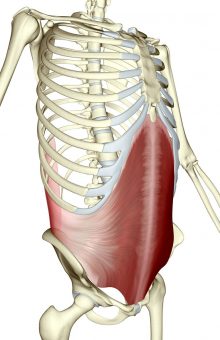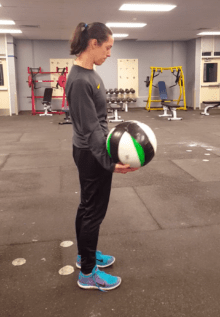Alternative Title: Describing the Avoidant Half I have been writing about asymmetries for some time. Whether it be determining the up leg from from down leg, or the pitfalls of detorsioning the system, I continue to find and… Read more ›
In my athlete days, which ended about 15 years ago, the goal was to NOT feel and just complete the tasks put to paper. It was something I was given or sought out — “more” was agreed upon by all… Read more ›
Torsion. We all have it: a particular line of twist running through our carriage, gripping us in a certain way and keeping us upright. Each fold and joint tells its story, whether you realize it or not. It’s how we… Read more ›
To recap Part One: Create a sense of intrigue Provide multiple points of entry Establish pockets of safety Ask instead of assume This sh*t’s hard (which is why so few do it) After the weight shift lesson , three of… Read more ›
This post serves as a follow up to: A Path Towards Harm. Otherwise titled: The things I did wrong when I didn’t pay attention or have compassionate patience. The tag to this blog used to read, “fix yourself.” But… Read more ›
This hurts. The most common reaction is to stop using it or doing that. It’s even the advice of many medical professionals. Rest, it is assumed, is a cure all. But what happens when this magic pill doesn’t work? When… Read more ›
This is another concept coming from the astute observations of Nicole Uno. The medical, fitness, and wellness worlds are fixated on correcting imbalances. Amidst all the readily available treatment plans, too few remain curious about why so many asymmetries… Read more ›
As I am learning to access and mobilize my ribs, I have begun to understand and control the deep inner workings of my trunk, particularly the space between the ribs and pelvis. One might think of this as the shortest… Read more ›
The following is a glimpse into the mind of Nicole Uno (IG @unotraining). Rotational Organization allows for the simultaneous existence between contract and relax. Thoroughly simplified, consider two gears. There is an impetus of force and a corresponding area… Read more ›
For a long time, I believed that extension was the working opposite of flexion. They felt as contrary as they looked. Folding forward was natural and effortless. Folding back was a resistance to that ease. The struggle was a lesson… Read more ›
Matan Levkowich is a dancer, choreographer, and martial artist. Another of the incredible Israeli movers, he is able to pluck out threads from all the worlds he has immersed himself in and deliver them in practical form. He first blipped… Read more ›
If you’re curious about why only half a workshop I’ll tell that story at the end. Tom Weksler’s Movement Archery workshop was a lesson in angular momentum. We rolled, we spun, we bruised our pointy bits. Imagine an archer… Read more ›
Movement expression is dependent on on our tadpole-like head and spine to drive and disperse motion. Any sticking points have a reverberatory effect on the actions of the limbs. After a decade of undoing the rigidity trained through athletics and… Read more ›
When I got my first chin up, I felt superhuman. Finally hitting that relative strength benchmark felt like a magic trick I was somehow involved in. Even more mystifying, though, is that I had absolutely nothing on a pronated grip… Read more ›
The low gait might be the truest test of healthy knees. It requires full flexion under full bodyweight while pulling the center of mass. A single knee is responsible for stabilizing load while the feet and ankles pivot and reposition.… Read more ›
Engaging with your work demands a certain degree of ownership. There must be a benefit to the challenge presented, beyond just a hard-to-apply confidence. A task can serve as a test of will, a test of adaptability, and/or a test… Read more ›
Doing without knowing. Playing, creating, learning. Adjusting and adapting. Describing Fighting Monkey is an act in organizing verbs. Everything overlaps and intertwines and is a wonder. The only certainty you are left with is that you have experienced something good… Read more ›
Issues with joints or body parts can almost always be traced back to usage. When faced with a familiar task in a familiar environment, our habitual patterns of movement follow a particular chain of command. We clutch and are clutched… Read more ›
“I’m going to explore the depths of the ocean.” “You’re gonna what?” “I’m going to get into this magical pressure suit, close myself off to the known world, and look for cool stuff.” “Why would you want to do… Read more ›
Movement overlaps. Brain work = joint work = speed, power, strength, and coordination work. We have structures and we have capacities. Our practice establishes the abilities of both. There is a general consensus that if your parts work better you’ll… Read more ›
Body control is all the rage. A popular want is increasing active range of motion. People want to get there so they can do stuff there. Functional Range Conditioning uses slow, controlled movement to examine individual joints, build capacity in… Read more ›
Hip extension is a vital movement to both health and performance. Wellness wise, hips that can extend, coupled with an unstuck spine and pelvis that can naturally posteriorly tilt, means you likely don’t suffer from back pain. Power and speed… Read more ›
Increasing dorsiflexion is a popular yet frustrating goal. Getting the ankles to do more lessens the strain on the knees, and is an important factor in being able to drop into a deep squat — an often used marker of overall… Read more ›
The vast majority of movements happen going forward. We reach, walk, look, and move toward what’s in front of us. Then we sit by pushing our butt backward. This front-to-back plane of motion (or stillness) is where we reside. Our… Read more ›
Pelvic motion and knee flexion influence hip rotation. Structures above and below a joint have a direct impact on the way it functions. For the hip, its surrounding articulations are the knee and the pelvis. Stiffness or motion in… Read more ›
For about two months, I’ve had some chronic discomfort in my left knee. On a scale of 1-10, with ’10’ being agony and ‘1’ being noticeable/annoying, it oscillates between 1 and 4. Though this might be thought of as acceptable… Read more ›
The pelvis speaks volumes. The position in which you hold it dictates whether or not you can use your abs, release your hip flexors, and/or likely have symptoms of back pain. It’s the first thing I check with new clients… Read more ›
We tend to move in ingrained patterns, within the same degrees and utilizing the same amount of space. Thinking bigger about what a joint is capable of doing allows us to use it in ways we don’t, which often aligns… Read more ›
Sliding is one of the most fun ways to get from here to there. True to form, it’s also a sneaky little way to grasp an underlying understanding of movement. F=ma (force equals mass times acceleration) is explained in… Read more ›
The tip toes position is an assessment of toes, feet, and ankle control. Balance comes from joint stacking. The push off when we walk comes from a high heel. A toe point or push is required with reaching. Loaded plantar… Read more ›
Thirteen years ago, I had ACL reconstruction surgery using a hamstring graft. My tissues have long since ‘healed’, but the overall function still lacks behind my non-injured leg. Full flexion remains it’s biggest weakness. Here’s snapshot of the discrepancy in… Read more ›
featured photo credit: morphopedics.wikidot.com Stiff hips cause pain, injury, and lackluster performance. A freely rotating hip is likely to flex, extend, abduct, and adduct with ease. Restrictions with any of these movements can often be traced back to restrictions in… Read more ›



































